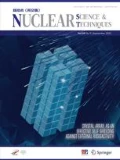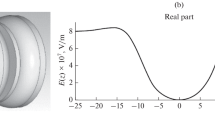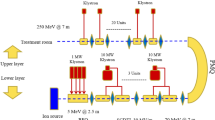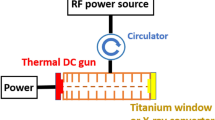Abstract
An S-band high-gradient accelerating structure is designed for a proton therapy linear accelerator (linac) to accommodate the new development of compact, single-room facilities and ultra-high dose rate (FLASH) radiotherapy. To optimize the design, an efficient optimization scheme is applied to improve the simulation efficiency. An S-band accelerating structure with 2856 MHz is designed with a low beta of 0.38, which is a difficult structure to achieve for a linac accelerating proton particles from 70 to 250 MeV, as a high gradient up to 50 MV/m is required. A special design involving a dual-feed coupler eliminates the dipole field effect. This paper presents all the details pertaining to the design, fabrication, and cold test results of the S-band high-gradient accelerating structure.






Similar content being viewed by others
References
R.R. Wilson, Radiological use of fast protons. Radiology 47, 487–491 (1946). https://doi.org/10.1148/47.5.487
R.C. Han, Y.J. Li, Y.H. Pu, Collection efficiency of a monitor parallel plate ionization chamber for pencil beam scanning proton therapy. Nucl. Sci. Tech. 31, 13 (2020). https://doi.org/10.1007/s41365-020-0722-z
Particle Therapy Cooperative Group (PTCOG) Collaboration. http://www.ptcog.com
R.S. Zheng, K.X. Sun, S.W. Zhang et al., Analysis on the prevalence of malignant tumors in China in 2015. Chin. J. Oncol. 41, 19–28 (2019). (in Chinese)
P. Montay-Gruel, A. Bouchet, M. Jaccard et al., X-rays can trigger the FLASH effect: ultra-high dose-rate synchrotron light source prevents normal brain injury after whole brain irradiation in mice. Radiother. Oncol. 129, 582–588 (2018). https://doi.org/10.1016/j.radonc.2018.08.016
R.W. Hamm, K.R. Crandall, J.M. Potter, Preliminary design of a dedicated proton therapy linac, in Conference Record of the 1991 IEEE Particle Accelerator Conference, (San Francisco, CA, USA, 1991), pp. 2583–2585. https://doi.org/10.1109/PAC.1991.165037
A.J. Lennox, Hospital-based proton linear accelerator for particle therapy and radioisotope production. Nucl. Inst. Methods Phys. Res. A 56-57, 1197–1200 (1991). https://doi.org/10.1016/0168-583X(91)95130-6
U. Amaldi, P. Berra, K. Crandall et al., LIBO—alinac—booster for proton therapy: construction and test of a prototype. Nucl. Inst. Methods Phys. Res. A 521, 512–529 (2004). https://doi.org/10.1016/j.nima.2003.07.062
C. Ronsivalle, A. Ampollini, G. Bazzano et al., The Top Implart Linac: machine status and experimental activity, in Proceedings of IPAC2017. ENEA C.R. Frascati, Frascati (Roma), Italy https://doi.org/10.18429/JACoW-IPAC2017-THPVA090.
S. Benedetti, A. Grudiev, A. Latina, High gradient linac for proton therapy. Phys. Rev. Accel. Beams 20, 040101 (2017). https://doi.org/10.1103/PhysRevAccelBeams.20.040101
H.Y. Li, X.M. Wan, W. Chen et al., Optimization of the S-band side-coupled cavities for proton acceleration. Nucl. Sci. Tech. 31, 23 (2020). https://doi.org/10.1007/s41365-020-0735-7
X.X. Huang, W.C. Fang, Q. Gu et al., Design of an X-band accelerating structure using a newly developed structural optimization procedure. Nucl. Instrum. Methods Phys. Res. A 834, 45–52 (2017). https://doi.org/10.1016/j.nima.2017.02.050
A. Degiovanni, R. Bonomi, M. Garlasché et al., High gradient rf test results of S-band and C-band cavities for medical linear accelerators. Nucl. Instrum. Methods Phys. Res. A 890, 1–7 (2018). https://doi.org/10.1016/j.nima.2018.01.079
A. Degiovanni, High gradient proton linacs for medical applications, Ph.d. thesis, EPFL (2014). https://doi.org/10.5075/epfl-thesis-6069
A. Degiovanni, U. Amaldi, R. Bonomi et al., TERA high gradient test program of rf cavities for medical linear accelerators. Nucl Instrum. Methods Phys. Res. A 657, 55–58 (2011). https://doi.org/10.1016/j.nima.2011.05.014
S. Benedetti, A. Ugo, D. Alberto et al., RF design of a novel S-band backward traveling wave linac for proton therapy, in Proceeding of 27th Linear Accelerator Conference, Geneva, Switzerland. THPP061 (2014). http://cds.cern.ch/record/2062620
S. Benedetti, T. Argyropoulos, C.B. Gutiérrez et al., Fabrication and testing of a novel S-band backward traveling wave accelerating structure for proton therapy linacs, in Proceedings of the 28th Linear Accelerator Conference, East Lansing, MI, USA, (2016). https://doi.org/10.18429/JACoW-LINAC2016-MOPLR048
Y. Nour, T. Abuelfadl, Design of X-band medical linear accelerator with multiple RF feeds and RF phase focusing, in Proceedings of IPAC2013, Shanghai, China (2013). https://accelconf.web.cern.ch/IPAC2013/papers/thpwa001.pdf
P.-F.R. Gapais, Bead-Pull measurements techniques and Multipoles components of DQW crab-cavity. CERN Summer Student 2018 Report. CERN-STUDENTS-Note-2018–144 https://cds.cern.ch/record/2638938
Author information
Authors and Affiliations
Contributions
All authors contributed to the study conception and design. Material preparation, data collection and analysis were performed by Yu Zhang, Wen-Cheng Fang, Xiao-Xia Huang, Jian-Hao Tan, Cheng Wang, Chao-Peng Wang and Zhen-Tang Zhao. The first draft of the manuscript was written by Yu Zhang and all authors commented on previous versions of the manuscript. All authors read and approved the final manuscript.
Corresponding author
Additional information
This work was supported by the Alliance of International Science Organizations (No. ANSO-CR-KP-2020-16).
Rights and permissions
Springer Nature or its licensor (e.g. a society or other partner) holds exclusive rights to this article under a publishing agreement with the author(s) or other rightsholder(s); author self-archiving of the accepted manuscript version of this article is solely governed by the terms of such publishing agreement and applicable law.
About this article
Cite this article
Zhang, Y., Fang, WC., Huang, XX. et al. Design, fabrication, and cold test of an S-band high-gradient accelerating structure for compact proton therapy facility. NUCL SCI TECH 32, 38 (2021). https://doi.org/10.1007/s41365-021-00869-z
Received:
Revised:
Accepted:
Published:
DOI: https://doi.org/10.1007/s41365-021-00869-z




